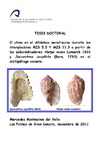Please use this identifier to cite or link to this item:
https://accedacris.ulpgc.es/jspui/handle/10553/8177
| Title: | El clima en el Atlántico norafricano durante los interglaciales MIS 5.5 y MIS 11.3 a partir de los paleoindicadores Harpa rosea Lamarck [1816] y Saccaostrea cucullata (Born, 1780) en el archipiélago canario | Other Titles: | North African climate during interglacial periods 'MIS 5.5' and 'MIS 11.3' by using the paleontological-indicators, Harpa rosea Lamarck 1816 and Saccostrea cucullata (Born, 1780) present in the Canary islands | Authors: | Montesinos Del Valle, Mercedes | Director: | González Ramos, Antonio Juan Meco Cabrera, Joaquín Francisco |
UNESCO Clasification: | 250205 Paleoclimatología 2416 Paleontología 240106 Ecología animal |
Keywords: | MIS 5.5 MIS 11.3 Saccostrea cucullata Harpa rosea SST, et al |
Issue Date: | 2012 | Abstract: | El hecho de que algunas especies de moluscos como Saccostrea cucullata (Born) y Harpa rosea Lamarck, de extrema exigencia ecológica, que habitan en el Golfo de
Guinea aparezcan fósiles en yacimientos de Canarias, ha permitido conocer condiciones oceánicas durante los últimos interglaciales (inicios del Pleistoceno superior y del Pleistoceno medio tardío) mediante modernas técnicas de teledetección espacial que permitirían comparar ambos entornos geográficos. Se han estudiado los Estadios Isotópicos Marinos (MIS) 5.5 y 11.3 por ser los más
parecidos al interglacial actual y se han seleccionado como paleoindicadores respectivos los fósiles más exigentes en cuanto a requerimiento de temperatura, el Harpa rosea Lamarck y la Saccostrea cucullata (Born). The fact that some species of molluscs Saccostrea cucullata (Born) and Harpa rosea Lamarck, both requiring extreme ecological conditions, which live in the Gulf of Guinea and appear in fossil deposits in the Canary Island, has made us know the ocean conditions during the last main interglacials (Middle Pleistocene and Upper Pleistocene) using modern remote sensing techniques that let us compare both spatial geographic environments. Marine Isotope Stages 5.5 and 11.3, the most similar to the current interglacial, have been studied and selected for this work as proxies respectives fossils, which are the most demanding in terms of temperature requirement, the Harpa rosea Lamarck and Saccostrea cucullata (Born). |
Description: | Programa de doctorado: Gestión de recursos vivos marinos y medioambiente (bienio 2006-2008) | Department: | Biología | Faculty: | Facultad de Ciencias del Mar | URI: | https://accedacris.ulpgc.es/handle/10553/8177 | Rights: | by-nc-nd |
| Appears in Collections: | Tesis doctoral |
Page view(s)
147
checked on May 18, 2024
Download(s)
585
checked on May 18, 2024
Google ScholarTM
Check
Share
Export metadata
Items in accedaCRIS are protected by copyright, with all rights reserved, unless otherwise indicated.
